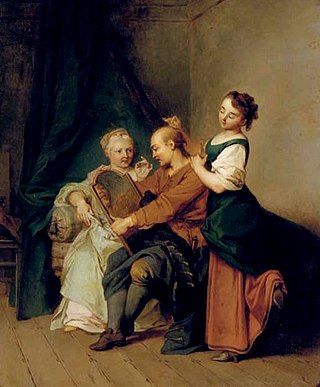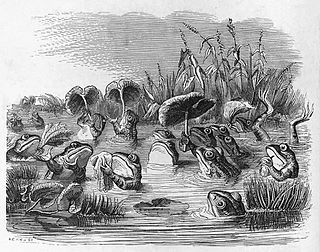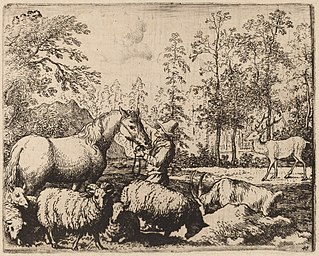
The Old Man and the Ass began as a fable with a political theme. Appearing among Aesop's Fables, it is numbered 476 in the Perry Index. [1]

The Old Man and the Ass began as a fable with a political theme. Appearing among Aesop's Fables, it is numbered 476 in the Perry Index. [1]
The fable as recorded by Phaedrus concerns an old man who tells his ass to fly with him on the approach of an army. The ass asks if they are liable to double his load and on being assured not, replies that, since his lot is to be a beast of burden, he is indifferent who is his owner. Phaedrus comments on the story that "When there is a change in government, nothing changes for the poor folk except their master's name." [2] Much the same conclusion is drawn in Hieronymus Osius's Neo-Latin poem, Asinus et vitulus (the ass and the herdboy). [3]
The story later appeared in La Fontaine's Fables as Le vieillard et l'âne (VI.8). Here the ass has been turned into a meadow and prefers to continue grazing rather than flee. Its conclusion is that, whoever is owner, "Our master is our enemy" (Notre ennemi, c'est notre maître). [4] This was translated into English by Charles Dennis in his Select Fables (1754) [5] and later by John Matthews, where he likened the situation to partitioned Poland. [6]
Laurentius Abstemius wrote a variant fable that appeared in his Hecatomythium (1490). [7] There it is a calf and an ass who discuss what to do in face of an advancing army. The calf is advised to run away since its life would be at stake, but in the ass' case "servants need not fear a change in masters, so long as they are no worse than the previous one". This seems to reference as well the changes for the worse in the story of The Ass and his Masters.

Fable is a literary genre defined as a succinct fictional story, in prose or verse, that features animals, legendary creatures, plants, inanimate objects, or forces of nature that are anthropomorphized, and that illustrates or leads to a particular moral lesson, which may at the end be added explicitly as a concise maxim or saying.

Gaius Julius Phaedrus, or Phaeder was a 1st-century AD Roman fabulist and the first versifier of a collection of Aesop's fables into Latin. Nothing is recorded of his life except for what can be inferred from his poems, and there was little mention of his work during late antiquity. It was not until the discovery of a few imperfect manuscripts during and following the Renaissance that his importance emerged, both as an author and in the transmission of the fables.

Aesop's Fables, or the Aesopica, is a collection of fables credited to Aesop, a slave and storyteller who lived in ancient Greece between 620 and 564 BCE. Of varied and unclear origins, the stories associated with his name have descended to modern times through a number of sources and continue to be reinterpreted in different verbal registers and in popular as well as artistic media.

The Fox and the Grapes is one of Aesop's Fables, numbered 15 in the Perry Index. The narration is concise and subsequent retellings have often been equally so. The story concerns a fox that tries to eat grapes from a vine but cannot reach them. Rather than admit defeat, he states they are undesirable. The expression "sour grapes" originated from this fable.

The Frog and the Ox appears among Aesop's Fables and is numbered 376 in the Perry Index. The story concerns a frog that tries to inflate itself to the size of an ox, but bursts in the attempt. It has usually been applied to socio-economic relations.
The Frogs Who Desired a King is one of Aesop's Fables and numbered 44 in the Perry Index. Throughout its history, the story has been given a political application.
The Lion, the Bear and the Fox is one of Aesop's Fables that is numbered 147 in the Perry Index. There are similar story types of both eastern and western origin in which two disputants lose the object of their dispute to a third.

The Wolf and the Lamb is a well-known fable of Aesop and is numbered 155 in the Perry Index. There are several variant stories of tyrannical injustice in which a victim is falsely accused and killed despite a reasonable defence.
The Ass and the Pig is one of Aesop's Fables that was never adopted in the West but has Eastern variants that remain popular. Their general teaching is that the easy life and seeming good fortune of others conceal a threat to their welfare.

The miller, his son and the donkey is a widely dispersed fable, number 721 in the Perry Index and number 1215 in the Aarne–Thompson classification systems of folklore narratives. Though it may have ancient analogues, the earliest extant version is in the work of the 13th-century Arab writer Ibn Said. There are many eastern versions of the tale and in Europe it was included in a number of Mediaeval collections. Since then it has been frequently included in collections of Aesop's fables as well as the influential Fables of Jean de la Fontaine.

Jean de La Fontaine collected fables from a wide variety of sources, both Western and Eastern, and adapted them into French free verse. They were issued under the general title of Fables in several volumes from 1668 to 1694 and are considered classics of French literature. Humorous, nuanced and ironical, they were originally aimed at adults but then entered the educational system and were required learning for school children.

The Dog and the Wolf is one of Aesop's Fables, numbered 346 in the Perry Index. It has been popular since antiquity as an object lesson of how freedom should not be exchanged for comfort or financial gain. An alternative fable with the same moral concerning different animals is less well known.

The Man with Two Mistresses is one of Aesop's Fables that deals directly with human foibles. It is numbered 31 in the Perry Index.

The Ass and his Masters is a fable that has also gone by the alternative titles The ass and the gardener and Jupiter and the ass. Included among Aesop's Fables, it is numbered 179 in the Perry Index.

The Frogs and the Sun is one of Aesop's Fables and is numbered 314 in the Perry Index. It has been given political applications since Classical times.
There are no less than six fables concerning an impertinent insect, which is taken in general to refer to the kind of interfering person who makes himself out falsely to share in the enterprise of others or to be of greater importance than he is in reality. Some of these stories are included among Aesop's Fables, while others are of later origin, and from them have been derived idioms in several languages.
"The man who runs after fortune" is the shortened title of La Fontaine's fable, L'homme qui court après la fortune et l'homme qui l'attend dans son lit. It is one of the few that is of La Fontaine's own invention but there are verbal echoes of other works. The title in the present tense points to the general lesson discussed in the prologue. The fable relates how an ambitious man suggests to his friend that they leave their small town together to seek their fortune. When his friend replies that he prefers to stay at home, the man departs to take up a position at Court. Not finding favour there, he next leaves to trade in the Orient but is no more successful. But when he gives up his pursuit and returns home at last, he find his friend in bed and Fortune sitting outside the door.

"The Lion Grown Old" is counted among Aesop's Fables and is numbered 481 in the Perry Index. It is used in illustration of the insults given those who have fallen from power and has a similar moral to the fable of The dogs and the lion's skin. Parallel proverbs of similar meaning were later associated with it.

The fable of how the horse lost its liberty in the course of settling a petty conflict exists in two versions involving either a stag or a boar and is numbered 269 in the Perry Index. When the story is told in a political context, it warns against seeking a remedy that leaves one worse off than before. Where economic circumstances are involved, it teaches that independence is always better than compromised plenty.

The animals sick of the plague is a dark fable by Jean de la Fontaine about the inequality of justice. It was published in 1678 at the head of his second volume of Fables (VII.1) and is generally considered one of his best.